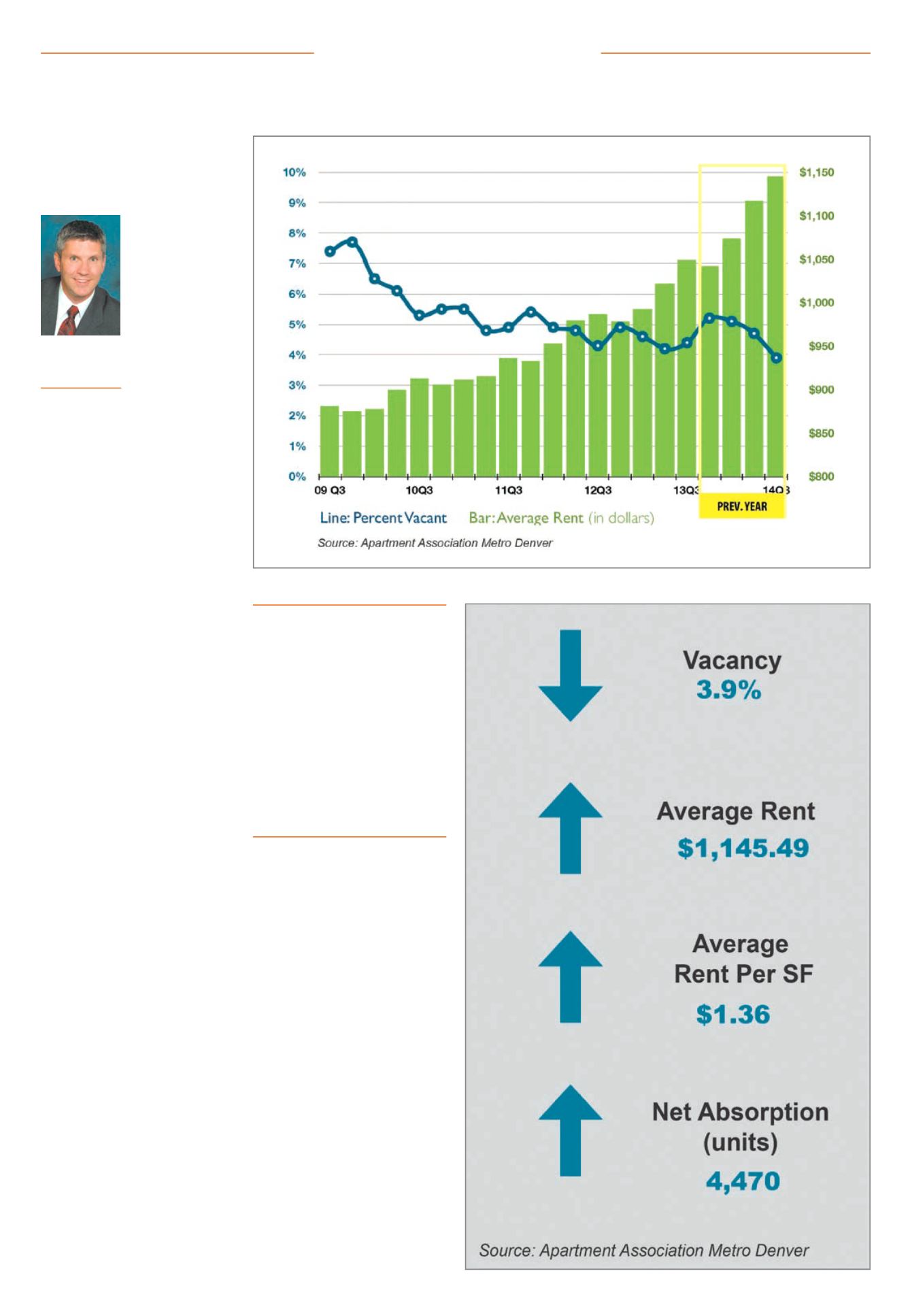

Page 4
— Multifamily Properties Quarterly — January 2015
A
s people flock to Colorado
for job opportunities and an
improved quality of life, the
apartment market has tight-
ened up to the point where
rents are rising steadily and inves-
tors continue to
aggressively pursue
any available multi-
family properties.
It’s no wonder
people are converg-
ing on Denver. Last
year, Forbes.com
ranked the city No.
4 on its list of the
10 best cities for job
seekers. The state’s
unemployment rate
stood at 4.3 percent
in October, with
Denver slightly bet-
ter at 4.2 percent.
Denver also landed on top of Busi-
ness Insider’s ranking of how each
state’s economy is faring, largely
because of the 1.2 percent growth
in the city’s working-age popula-
tion and the addition of 66,300 jobs
between June 2013 and June 2014.
Business Insider ranked Denver as
the fifth-best city for entrepreneurs
based on access to funds, networking
and mentorship opportunities, the
local economy and affordability.
Investors in the multifamily sec-
tor are taking note. In 2013, inves-
tors set a metro Denver record with
apartment sales of nearly $2.9 bil-
lion. They may come close to that
volume for 2014, depending on how
the fourth-quarter numbers shake
out, which come out at the end of
this month. But the market could
soften in 2015 or 2016 as many of the
projects that are under construction
are delivered, though many in the
industry believe Denver’s market is
not overbuilt yet.
More than 19,000 apartment units
started construction in 2012 and
2013, with most of them delivered
by the end of 2014. That’s the most
apartments added to the market in
such a short time period in more
than 40 years.
The boom in construction projects
in Denver follows a period that saw
little development of apartments and
now is filling a need that will help
the housing market catch up with
the demand created by population
growth. Downtown Denver is par-
ticularly hot, with about 4,000 units
under construction, the majority of
which surround the Denver Union
Station transit and hotel develop-
ment. Many of the other multifam-
ily projects under construction or
recently completed also are along
the transit system throughout the
metro region.
Even with all the inventory added
to the market, the vacancy rate con-
tinues to drop. It decreased to 3.9
percent in the third quarter of 2014
from 4.7 percent in the second quar-
ter. A vacancy rate of 5 percent is
considered normal and healthy.
The dropping vacancy rate trans-
lates into rising rents. Average rents
increased to $1,145 in the second
quarter, compared with $1,049 dur-
ing the same period last year and
$986 a year ago. Denver tied San
Diego for the highest rent growth in
2013 at 7 percent, according to an
analysis of the top 10 markets for
apartment investment by National
Real Estate Investor.
Developers and investors were
quick to enter the multifamily arena,
because it’s the sector that has the
most access to financing for con-
struction and acquisition. It’s also
an alternative to developing condo-
miniums – a risky prospect because
of the state’s onerous construction
defect law that make it easy for
homeowners to sue over property
defects.
Dropping vacancies, rising rents
and increased investor demand are
pushing the value of multifamily
properties up, meaning the assess-
ments due out in May are likely to
rise again. Assessments, conducted
every two years, were up as much
as 40 percent in some areas in May
2013.
New valuations will be based on
properties sold between July 1, 2012,
and June 30, 2014. By some esti-
mates, prices paid for properties
sold during that time frame have
increased as much as 89 percent.
Though owners will be able to raise
rents to cover the increase in prop-
erty taxes caused by higher assess-
ments, some may choose to sell
instead.
A steep ramp-up in construction
usually weakens a market’s overall
fundamentals, but the Denver metro
area’s strong economy seems able to
absorb the new supply, and it should
fuel enough demand for apartments
to prevent severe declines in funda-
mentals in the near term.
s
Denver investors, developers remain aggressiveDenver Metro Update
Jeff Johnson
Principal, Pinnacle
Real Estate
Advisors, Denver
Vacancy rate compared to average rent prices through third-quarter 2014
Changes from second-quarter to third-quarter 2014 figures for vacancy, rent and
absorption
Dropping
vacancies, rising
rents and increased
investor demand
are pushing the
value of multifamily
properties up.
















